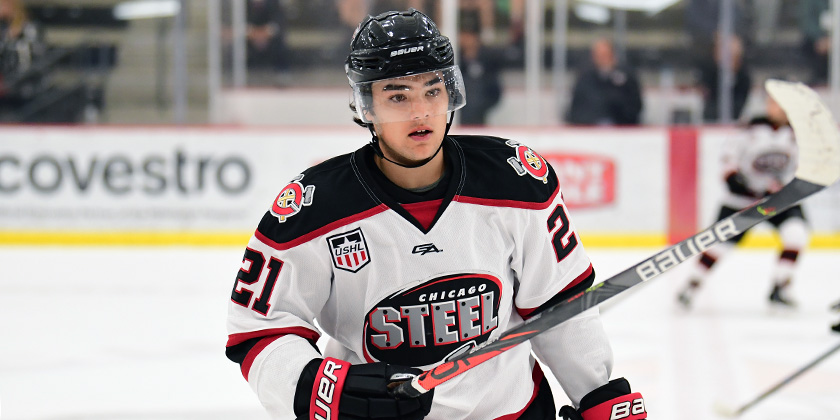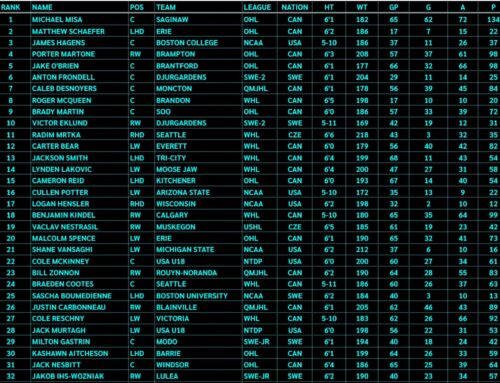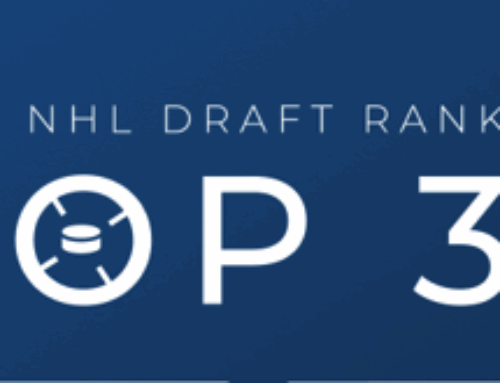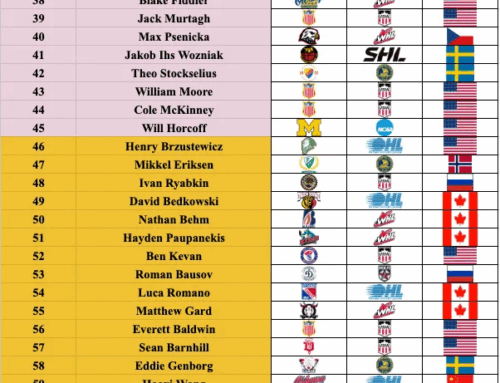December USHL Report
Hadi Kalakeche
2020-12-09

Photo courtesy of Neutral Zone Hockey
The USHL is a league that produces more and more NHL talent with every passing Draft class; in 2013, only one player from the USHL (Michael McCarron, 25th overall) was drafted within the first thirty picks. He was a costly reach at that position, as the Canadiens prospect did not amount to a prominent NHL role and Montreal missed out on top-end talent Shea Theodore, chosen right after the American-born right-winger. In comparison, 2019 yielded nine USHL first-round picks, seven of which were in the top-16, and most of whom look to be promising NHL players in the near future.
A large part of first-round picks from the USHL are chosen from within the United States National Development Program (USNTDP), which recruits the best under-18 talents from around the country to compete for roster spots and face 15 other teams in the most important Junior league in the United States. The players who cannot make the USNTDP roster or outgrow their eligibility then commit to the other USHL teams in the league, who can retain players up to 21 years old. Players from the USHL then, for the most part, commit to NCAA teams and complete their higher education as they square up against men in a 30-game season.
However, with every passing year, the general level of USHL teams creeps up, as the teams acquire more and more offshore talent to develop and the USNTDP’s cuts get better and better. As a result, the Chicago Steel have been dominating the circuit despite having one of the youngest teams in the league, and currently have two forwards eligible for the 2021 NHL draft leading their scoring race in Matthew Coronato and Matthew Samoskevich, both of whom could compete for a first-round spot.
The Steel currently sit atop the Western division of the USHL through seven games, and their leading scorers are Coronato with 17 points, followed by the Canadiens’ 2020 fourth-round pick Sean Farrell and Matthew Samoskevich with 13. They are currently the top-three scorers of the USHL as a whole, and their play has been more than impressive. Coronato especially has a dynamic, invasive style of play that puts defenders on their heels and creates tons of space to exploit. He understands his responsibilities when a loose puck rears its head, and works around his teammates’ playing styles, rather than despite them. He plays on a different line at 5v5 than Farrell and Samoskevich, who play together; Coronato plays with the team’s captain Erik Middendorf, and assistant captain Adam Robbins, both of whom are 20 years old and seasoned USHL veterans. All three of the Steel’s top scorers do share powerplay time, however, which is where the offense has been flowing for Chicago.
Sean Farrell, who was quick to be labeled a “Steel” coming out of the 2020 NHL Draft, has been proving scouts right with his overall ability to generate dangerous scoring chances. He has a knack for putting shots through layers of defense and fooling the goaltender with his hard-to-read shot mechanics and can do the same with his passes, which often cross multiple seams and debris to reach an opponent in a better scoring position. His skating, stick-handling, and stick-checking are all above-average, and he uses all of his tools in combination when he plays. His overall game is quite elevated due to his impressive reactivity and hockey sense. He makes the right decisions and does so quickly.
Matthew Samoskevich, on the other hand, is a player that excels with time and space; he can slow down the play to his benefit on the man-advantage, but when the puck is going North-South at 5v5 or 4v4 and his reaction time needs to be quick, he can get lost on occasions. His skating is above-average, but not where you want it to be for a player his size (EliteProspects has him at 5-9, 172 pounds, but he looks slightly bigger, maybe 5-10 or 5-11, 180 pounds).
When a player excels with time and space but does not have exceptional speed or agility, you need them to have the hockey sense to be able to recognize what they need to do before everyone else does, in order for them to have the time to make their play (Ryan O’Reilly, Mark Stone, and Nick Suzuki are prime examples of this). In limited viewings, I have yet to see that level of hockey sense from Samoskevich, although his offensive prowess is on display when he has the puck on his stick. He can stickhandle in tight, make goalies look foolish with forehand-backhand dekes, and set himself up well for passes and shots with small puck adjustments on the fly.
As he gets drafted into the NHL and is taken in charge by a professional development team, they might need to choose whether they want to focus on Samoskevich’s skating and reactivity to help him require less time to make plays, or if they want to improve his vision and anticipation to ensure that he can find the right play before his opponents can read it, in order to take his time and still generate positive results. Both paths of development have their merits, and could pave the road to Samoskevich’s NHL career – what player he becomes, however, is the main variable in this equation.
For analytical purposes, here are the Three Musketeers’ advanced statistics* in the year prior to their draft eligibility, specifically regarding scoring chance generation (Farrell’s statistics are from 2018-2019, his Draft -1 year, to compare at equal development stages). Most of these statistics will be adjusted for ice-time by rounding up all three players’ performance over 60 minutes:
Shot percentage (how many of their shots were goals):
- Farrell 21.62% (highest among USHL players his age in 2018-2019)
- Coronato 20.22% (highest among USHL players his age in 2019-2020)
- Samoskevich 15.42% (11th among USHL players his age in 2019-2020)
Shots per 60 minutes of ice-time:
- Coronato 7.5
- Samoskevich 7.3
- Farrell 6.15
Primary points per 60 minutes of ice-time:
- Coronato 2.89 (third-highest among USHL players his age in 2019-2020)
- Farrell 2.67 (highest among USHL players his age in 2018-2019)
- Samoskevich 2.35 (fifth-highest among USHL players his age in 2019-2020)
Even-strength primary points per 60 minutes of ice-time:
- Coronato 2.47
- Samoskevich 2.00
- Farrell 1.83
EV GF% rel. (how much better/worse the team’s even-strength goal differential was with the player on the ice):
- Samoskevich 2.5% better
- Coronato 1.01% better
- Sean Farrell 4.62% worse
These metrics allow to visualize the three players’ influence on offense and scoring chance generation; Coronato was already showing signs of high offensive potential in 2019-2020, and his potential is solidifying this year as he is on pace for a 116-point season over 48 games. Obviously, such a result is unrealistic, and Coronato will likely finish around 70 points. However, seeing high offensive output from a draft-year player in the USHL, although promising, is not a guarantee of success; regular NHLers like Patrick Sharp, Jordan Greenway, Ryan Dzingel and Bryan Rust all finished with under a point per game in their draft-year USHL season, whereas Taylor Cammarata collected 93 points in 59 games in his draft year in 2013, and is currently struggling in the ECHL. As for Farrell, his level of understanding of the game and his general success with any play he attempts should carry well into higher levels of hockey, whereas Samoskevich has room for improvement but shows signs of upside that are not to be neglected.
Together, the three top scorers in the USHL are leading the Steel to greater success within a league that is often dominated by the NTDP, but that has now allowed room for other teams to grow within the circuit and develop into high-level hockey schools. As the next months of the 2020-2021 season play out, the various teams within the league will develop their tactics further and adjust to the Steel’s top-heavy offense, and Chicago’s top scorers will need to adjust to that adversity; as the season rolls on, we will have a much better idea of how Coronato, Farrell and Samoskevich will adjust to ever-tougher, ever-more ready opposition.






